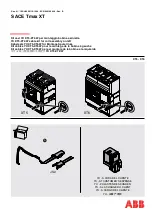
SECTION
10-
Type SST Overcurrent Trip Device (Cont.)
FIG. 58 - SST PROGRAMMER
46
FIG. 59 - AKR-58-30
1 0.2 CURRENT SENSORS
The SST system uses two types of current sensors,
·
phase sensor and a neutral sensor. Fig.
60
shows a phast.
sensor. Fig.
61
shows the neutral sensors available. The
current sensor supplies the power and sig nal inputs
necessary to operate the trip system . Each sensor has four
taps which provide field adjustment of the trip device's
continuous ampere rating.
The SST Ground Fau!t trip element operates on the
principle that the instantaneous values of current in the
three conductors (four on 4-wire systems) add to zero
unless ground current exists. On SST's equipped with
Ground Fault, the ground trip signal is developed by con
nectmg each phase sensor in series with a companion
pnmary winding on a ground differential transformer
mounted in the programmer unit. Its secondary output is
zero so long as there is not ground current.
Application of the Ground Fault element on 4-wire sys·
tems w1th neutral grounded at the transformer requires the
add1hona1. separately mounted neutral sensor (Fig.
61 )
mserted 1n the neutral conductor: its secondary is con
nected to a fourth primary windmg on the ground differen
tial transformer. See Fig .
70 .
This "fourth-wire" neutral
sensor 1s an electncal duplicate of the phase sensor, in
cludmg taps . Therefore, when taps are changed on the
phase sensors. those on the neutral sensor must
be
cor
respondingly posit1oned.
When used. the neutral sensor is separately mounted ir
the bus or cable compartment of the switchgear. In draw
out construction. its output is automatically connected to
the breaker v1a secondary disconnect blocks. See Fig.
62.
www
. ElectricalPartManuals
. com











































